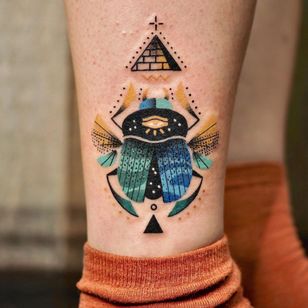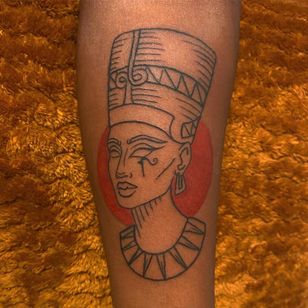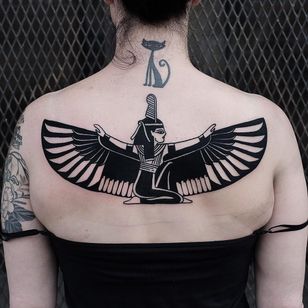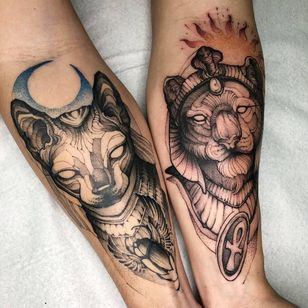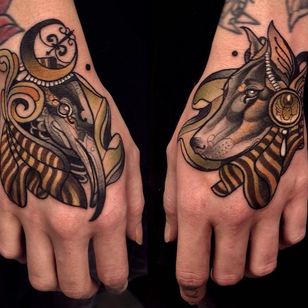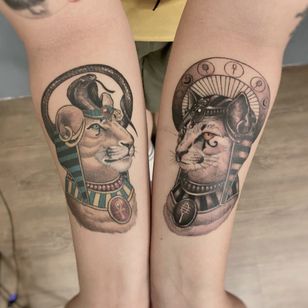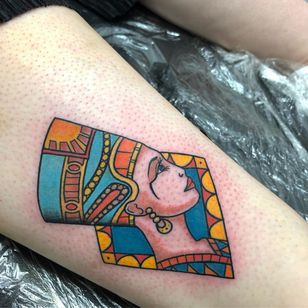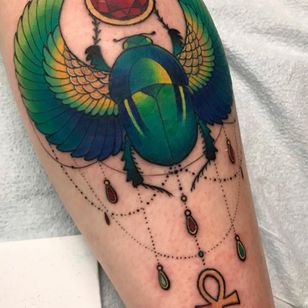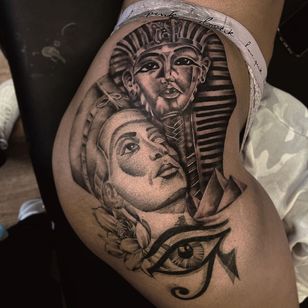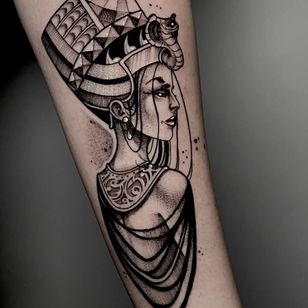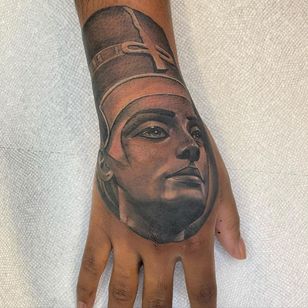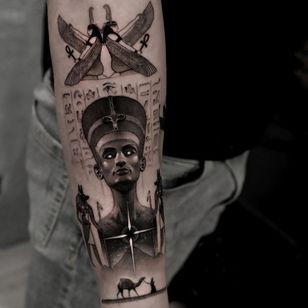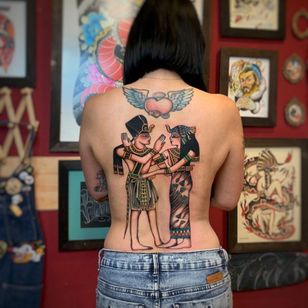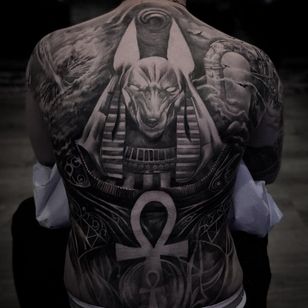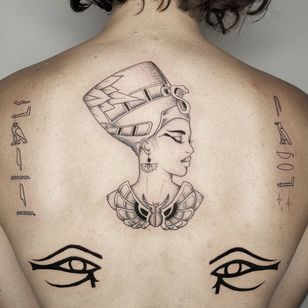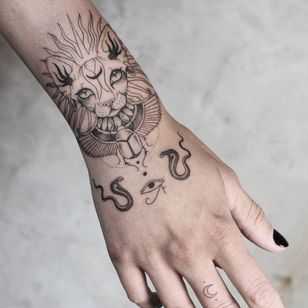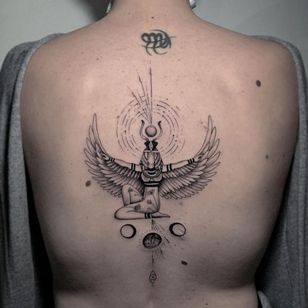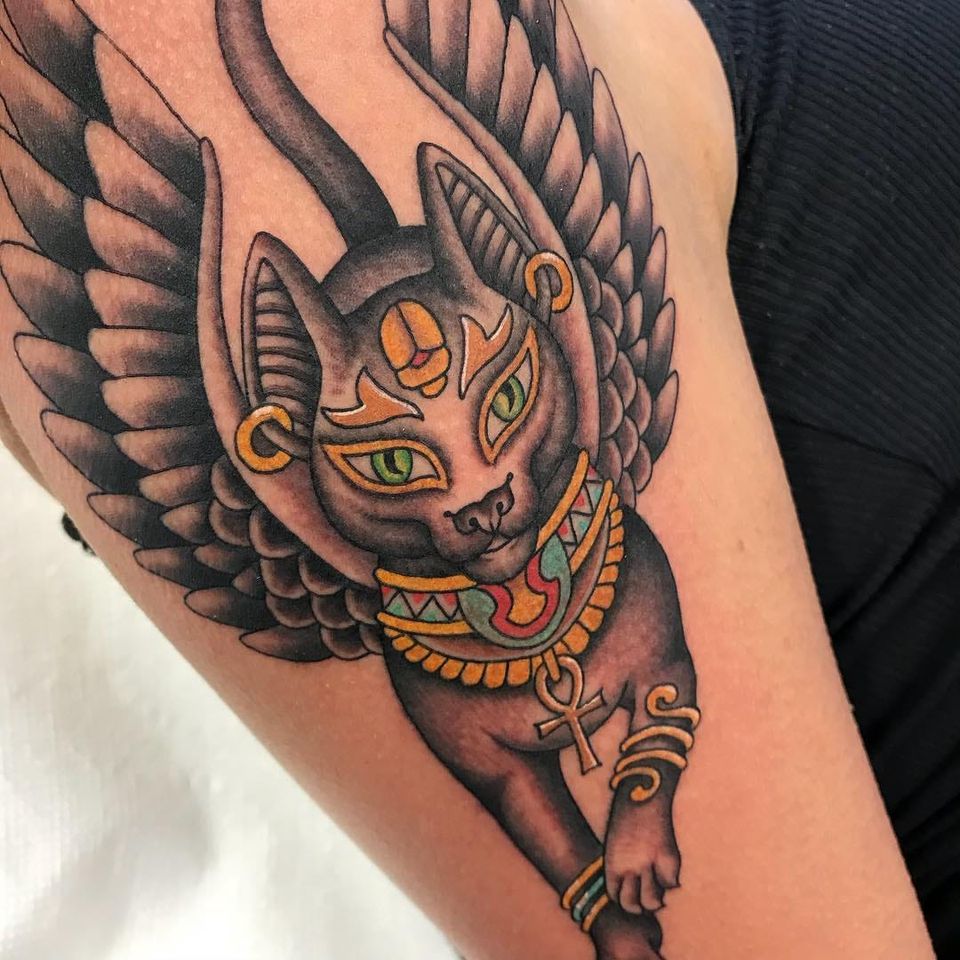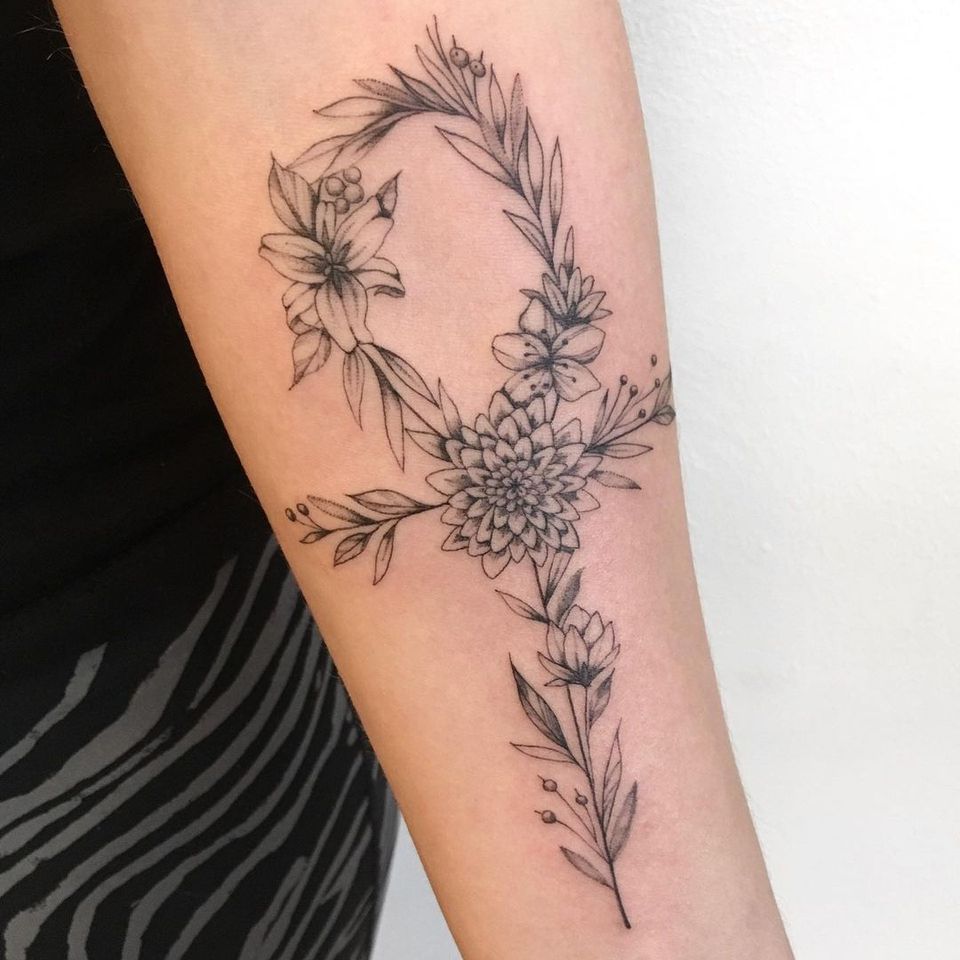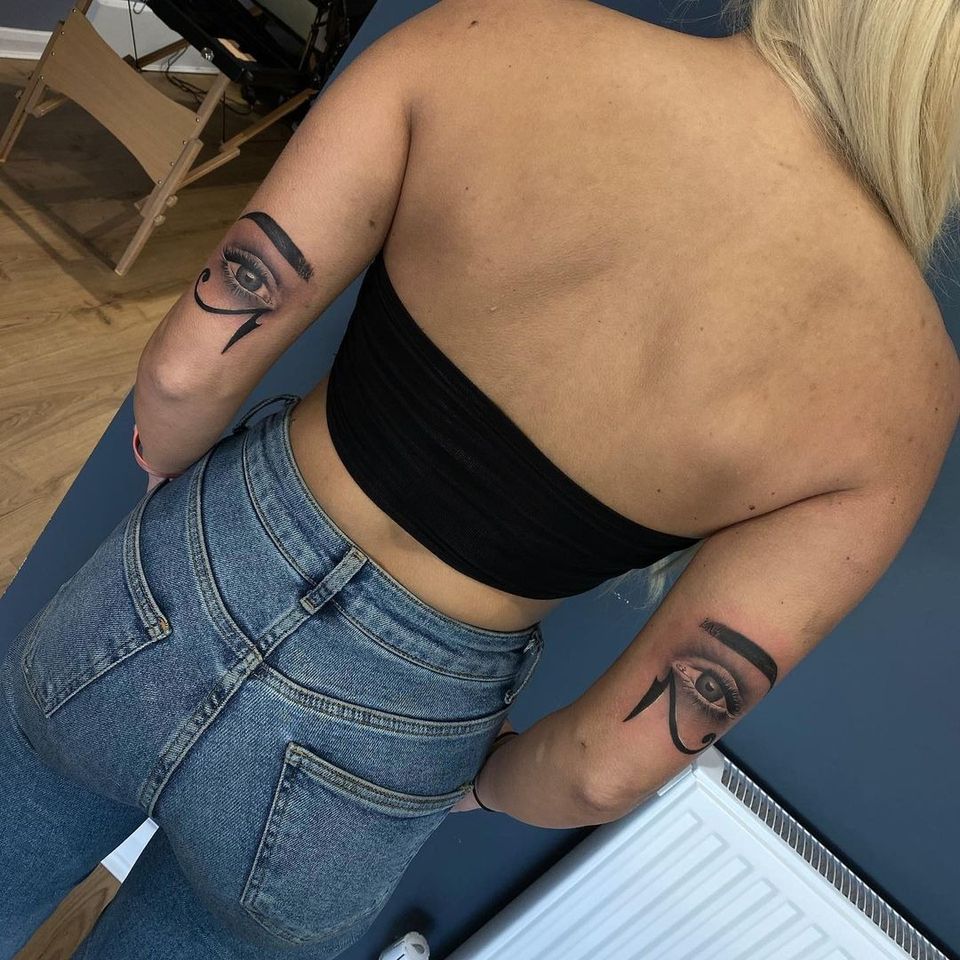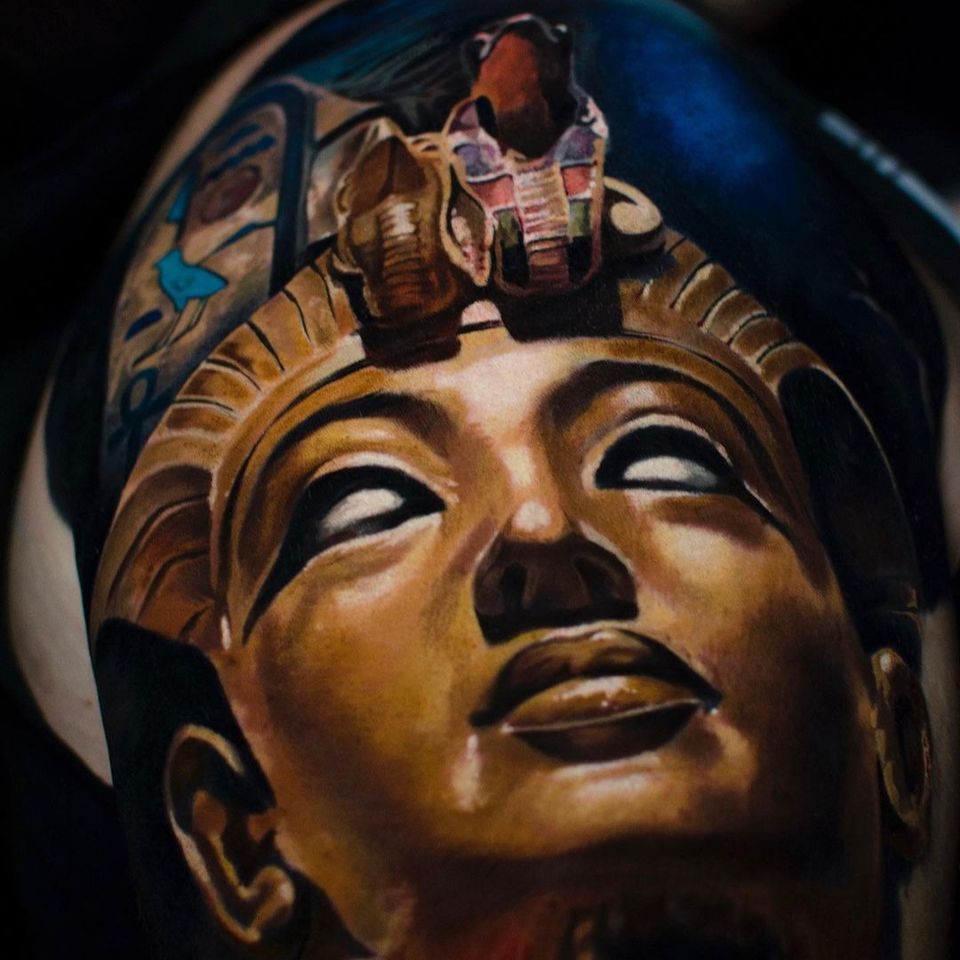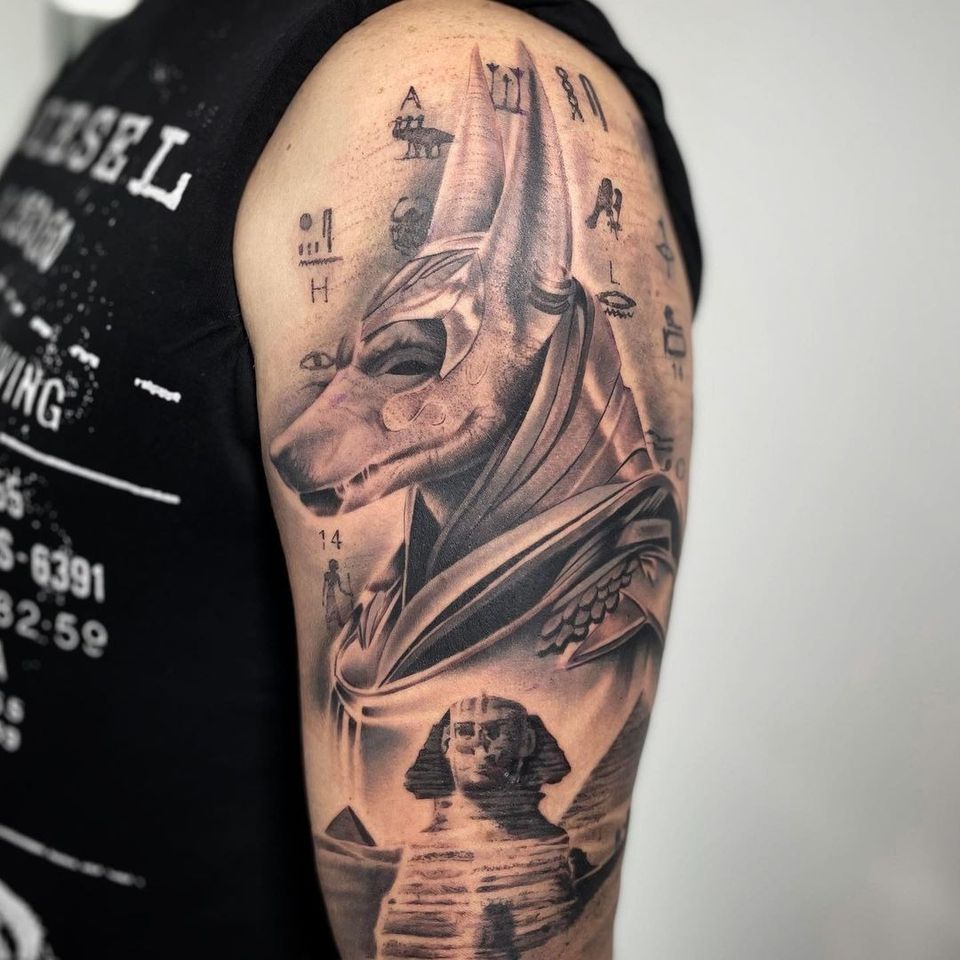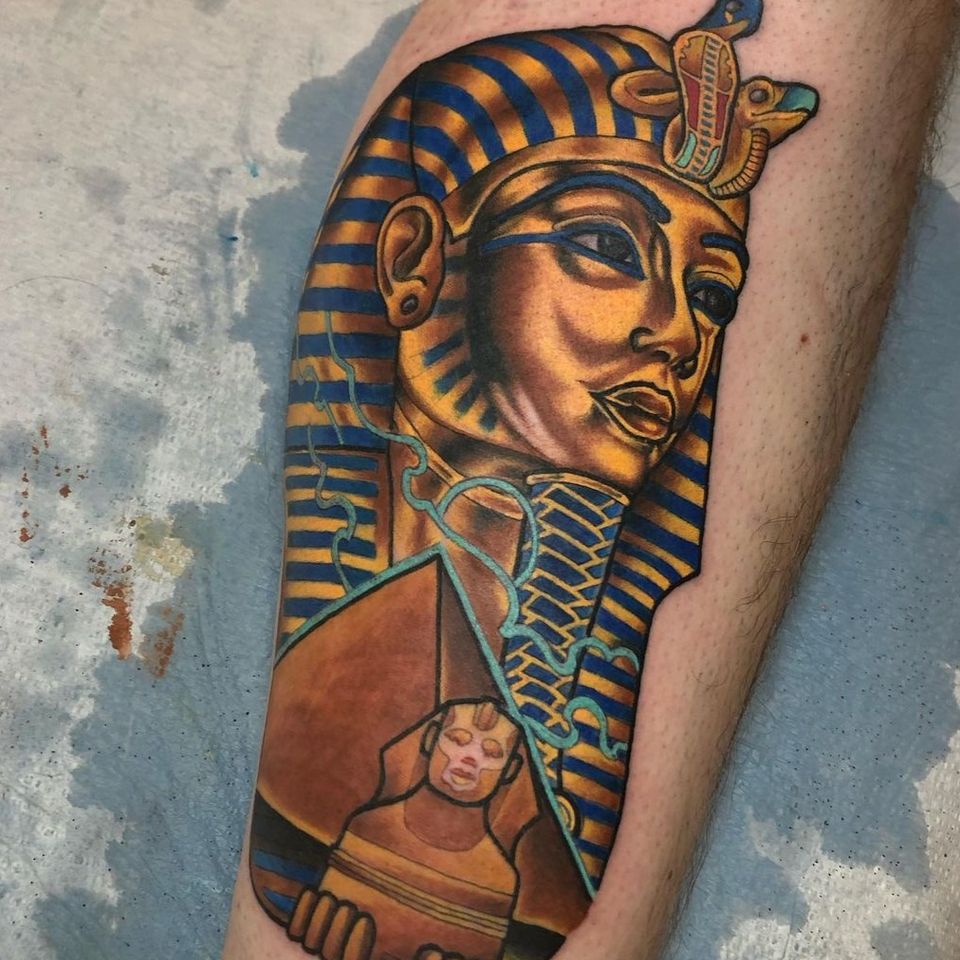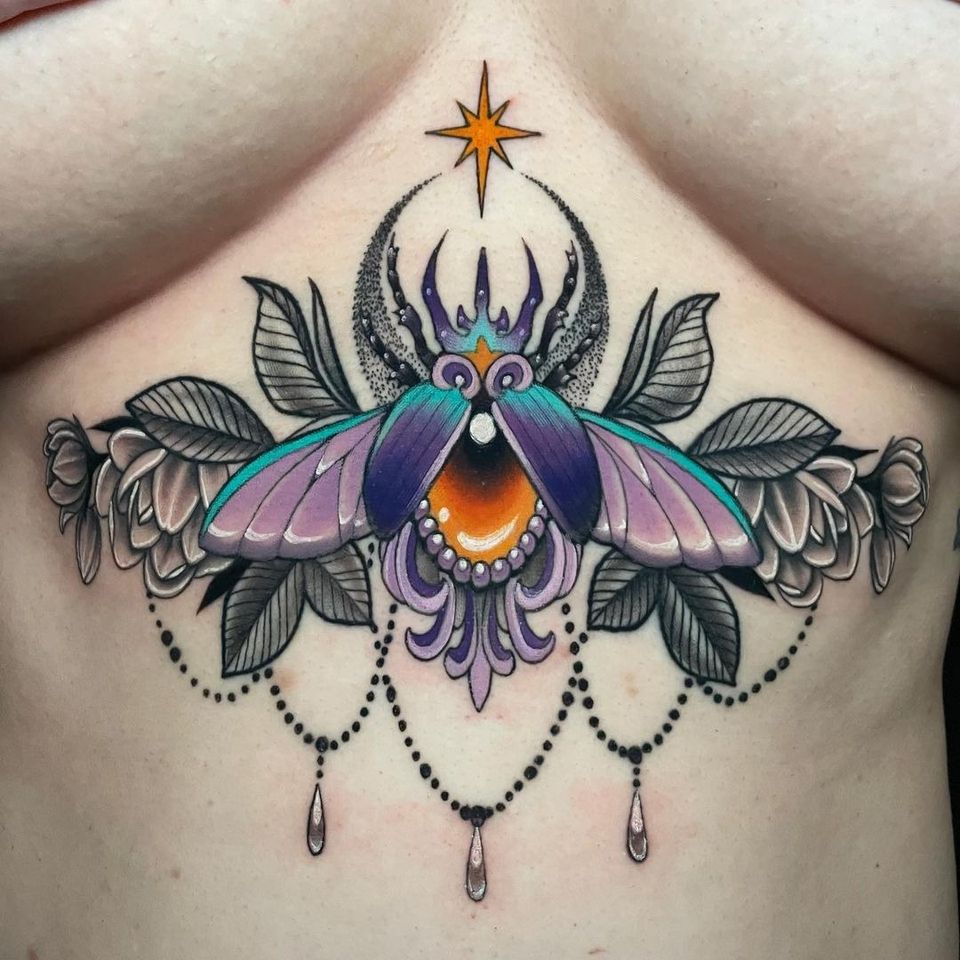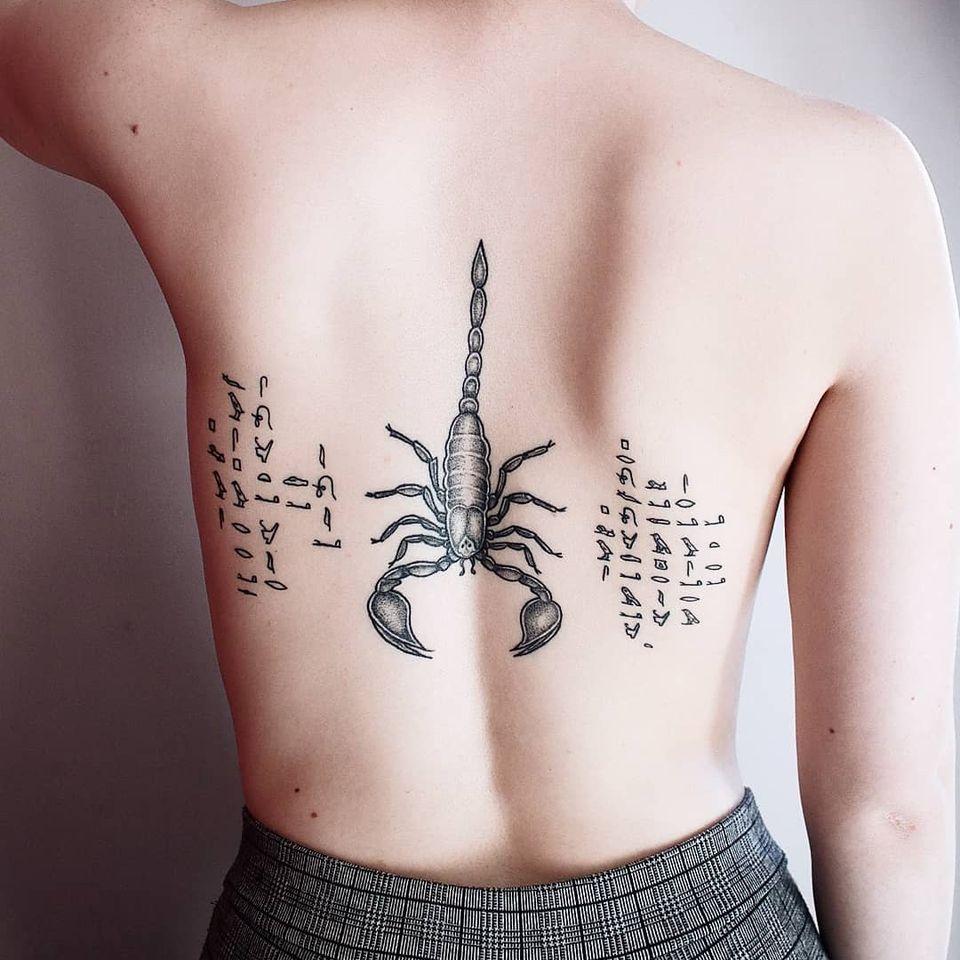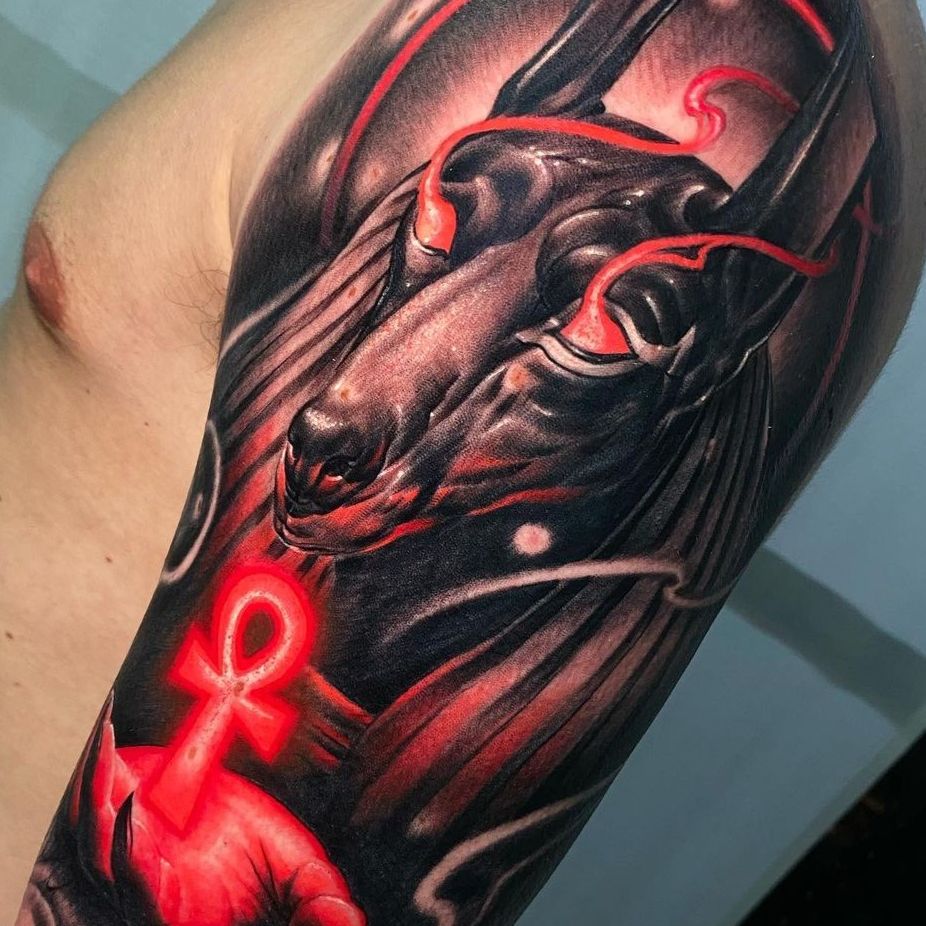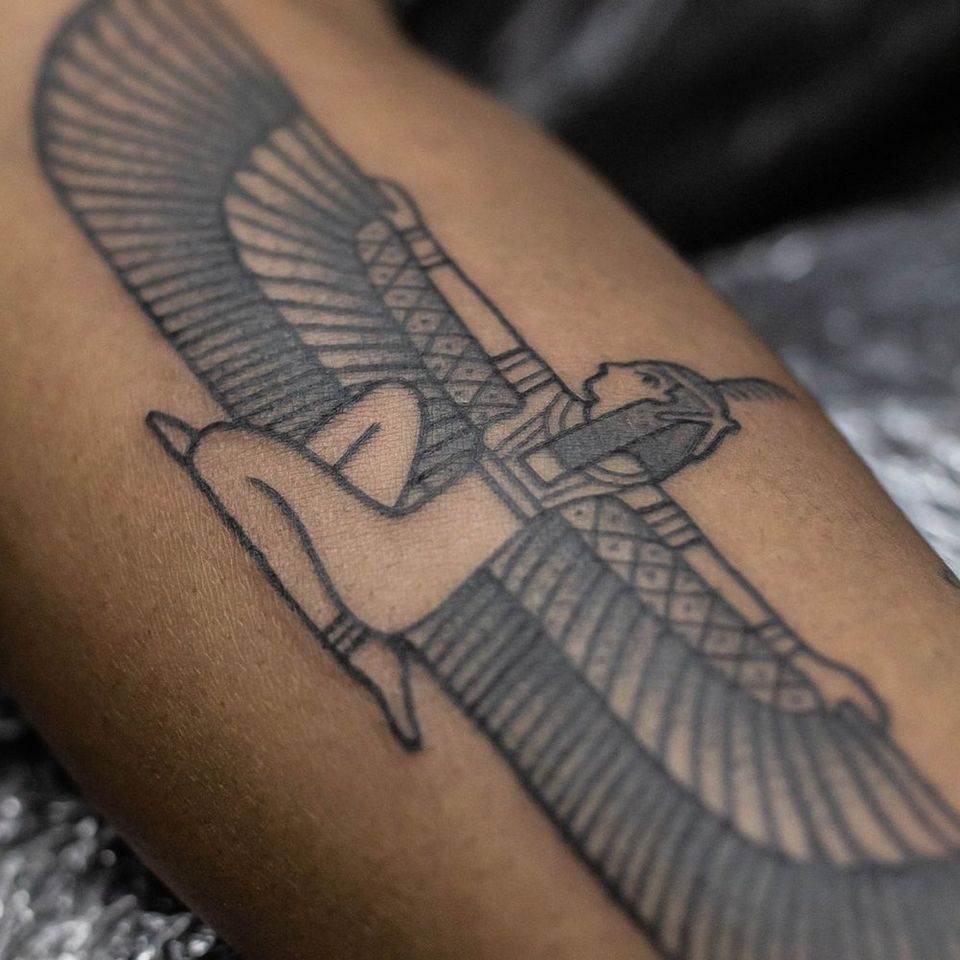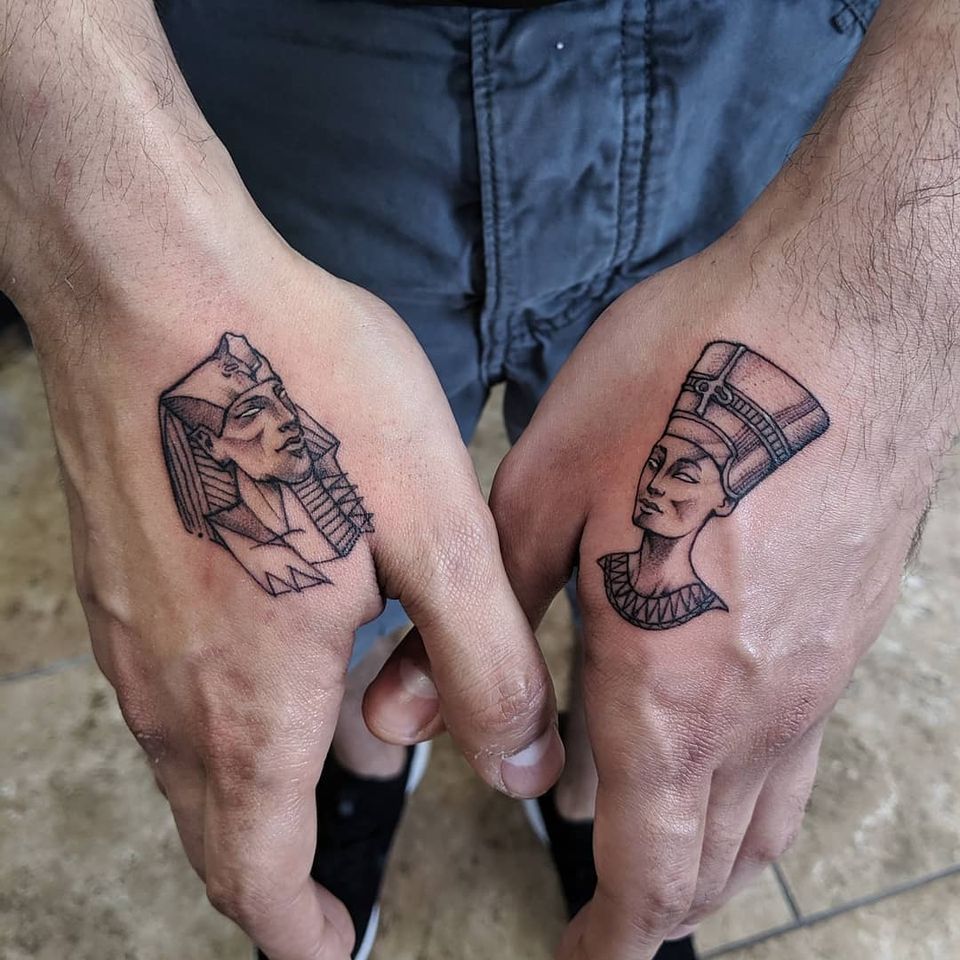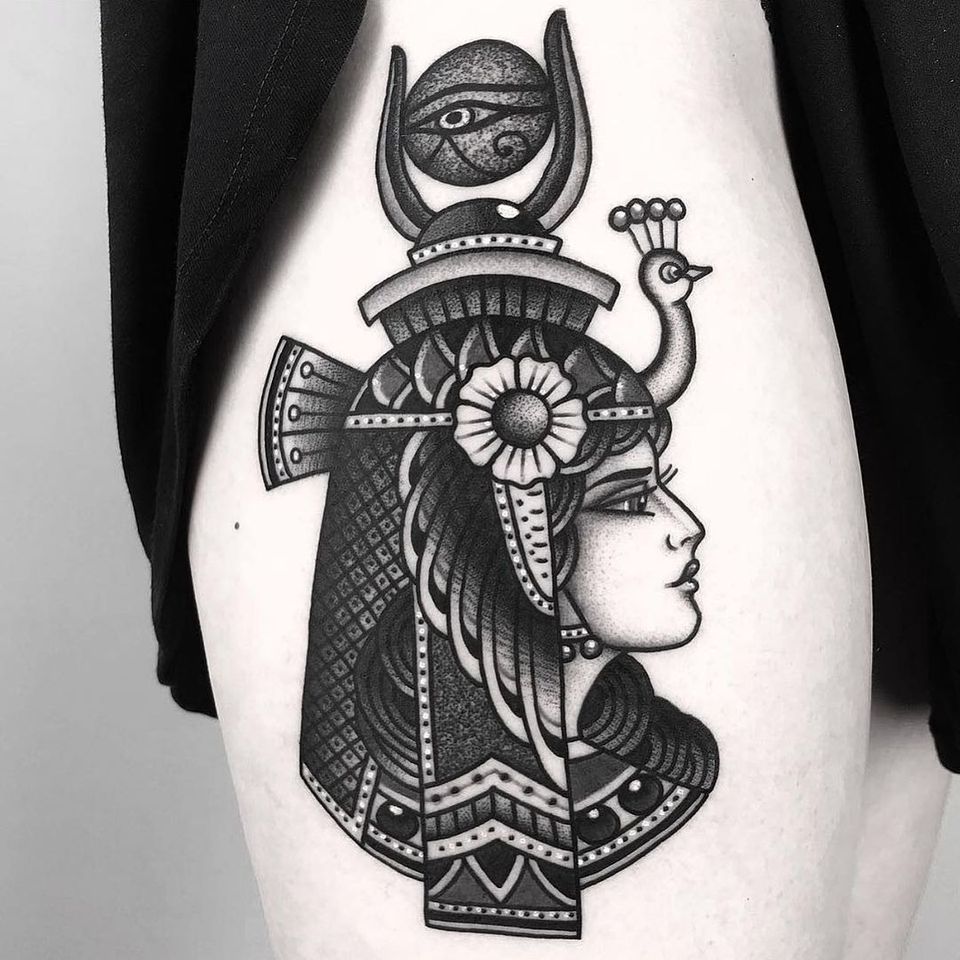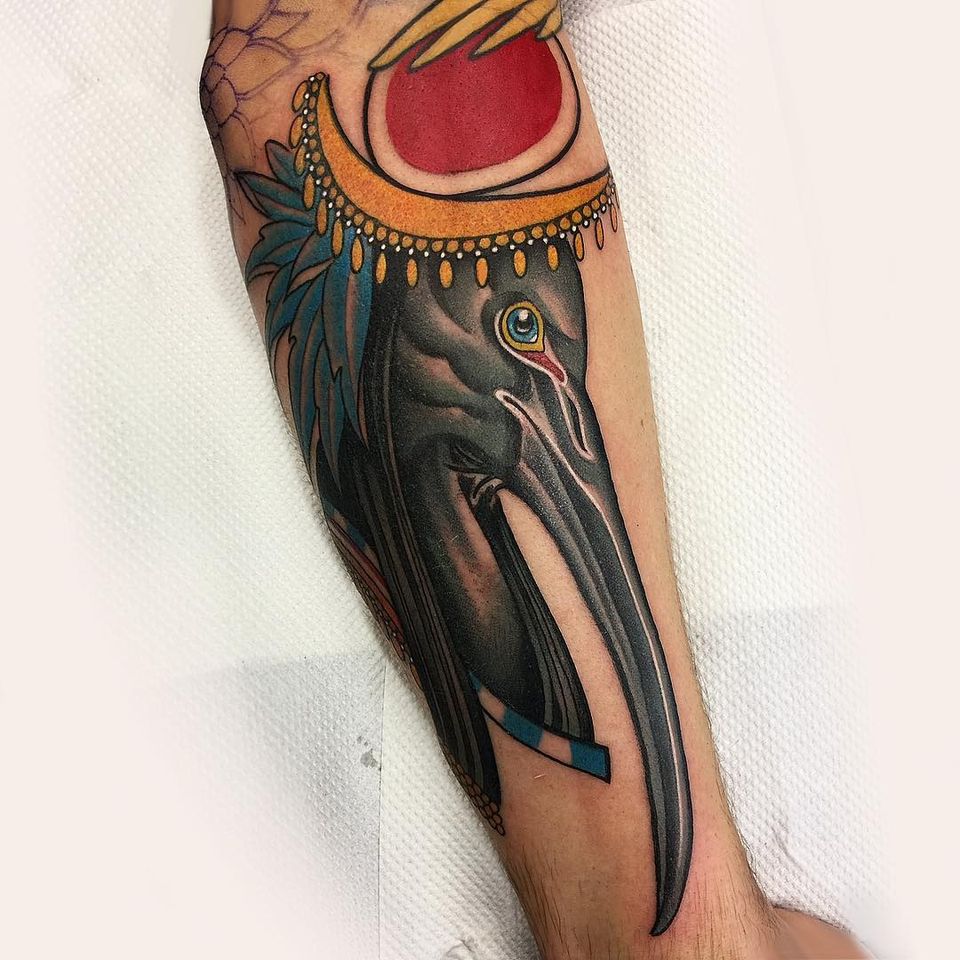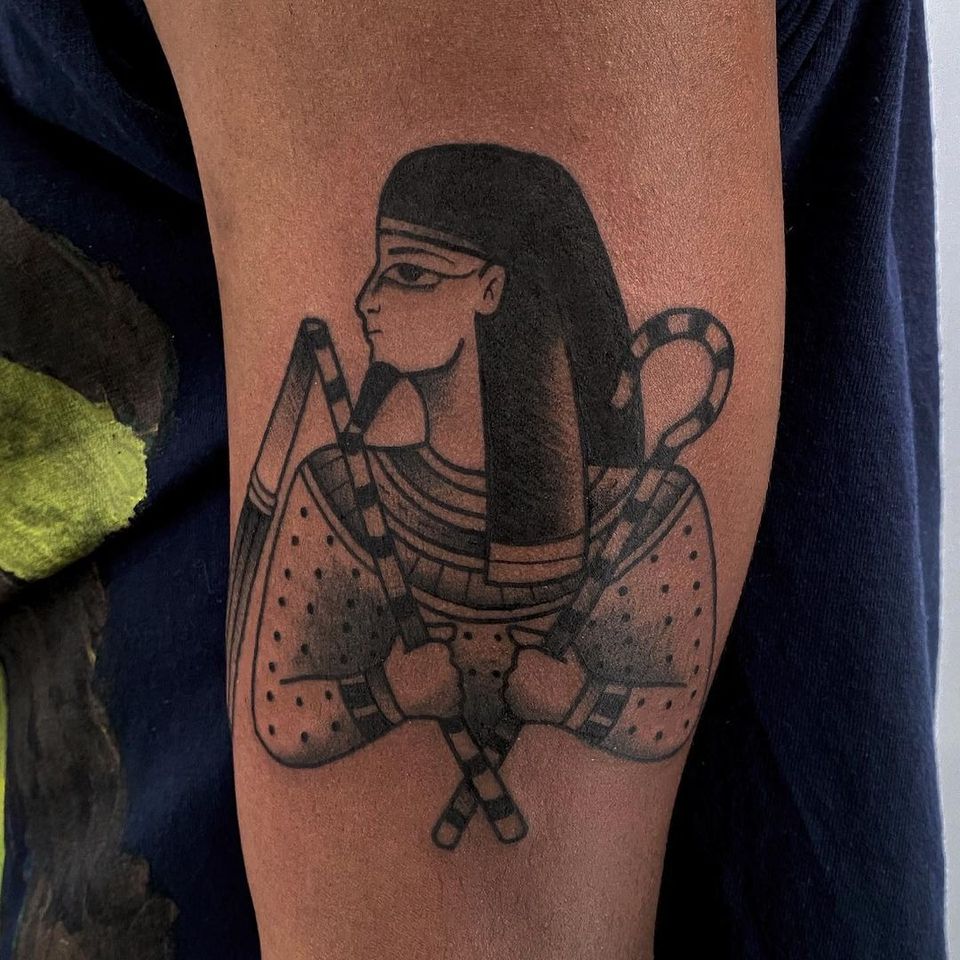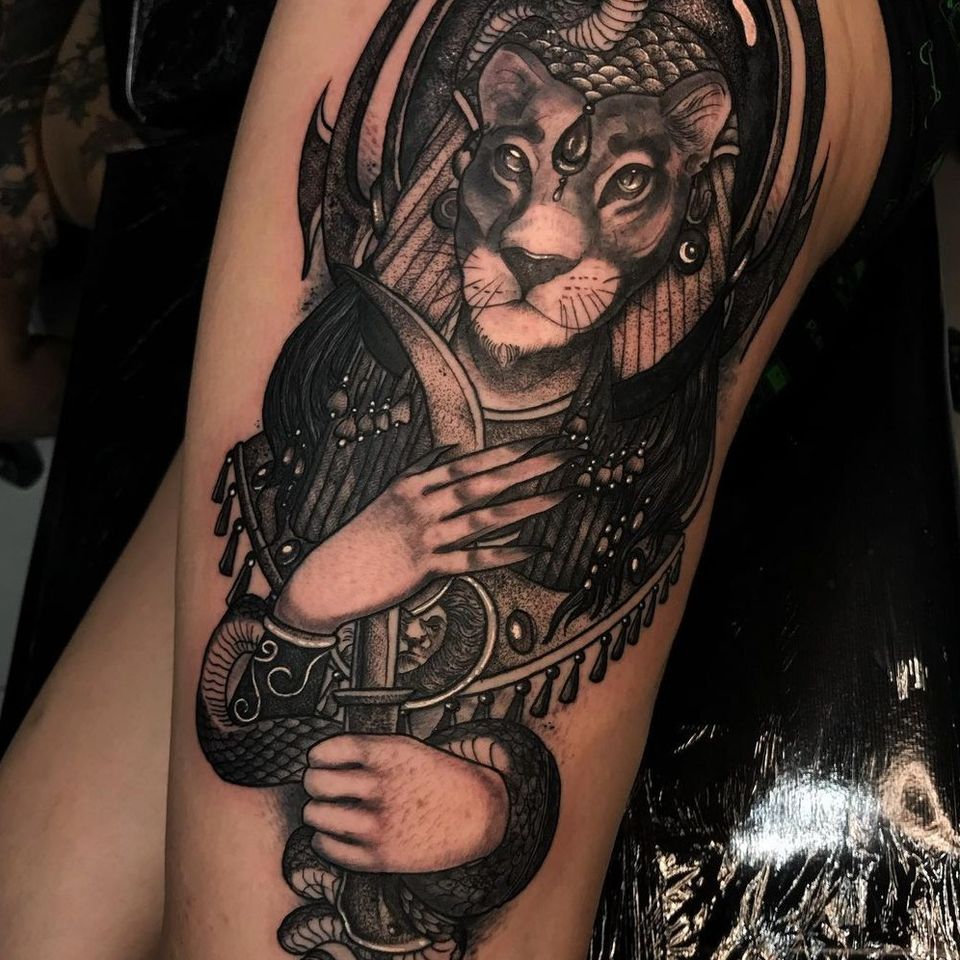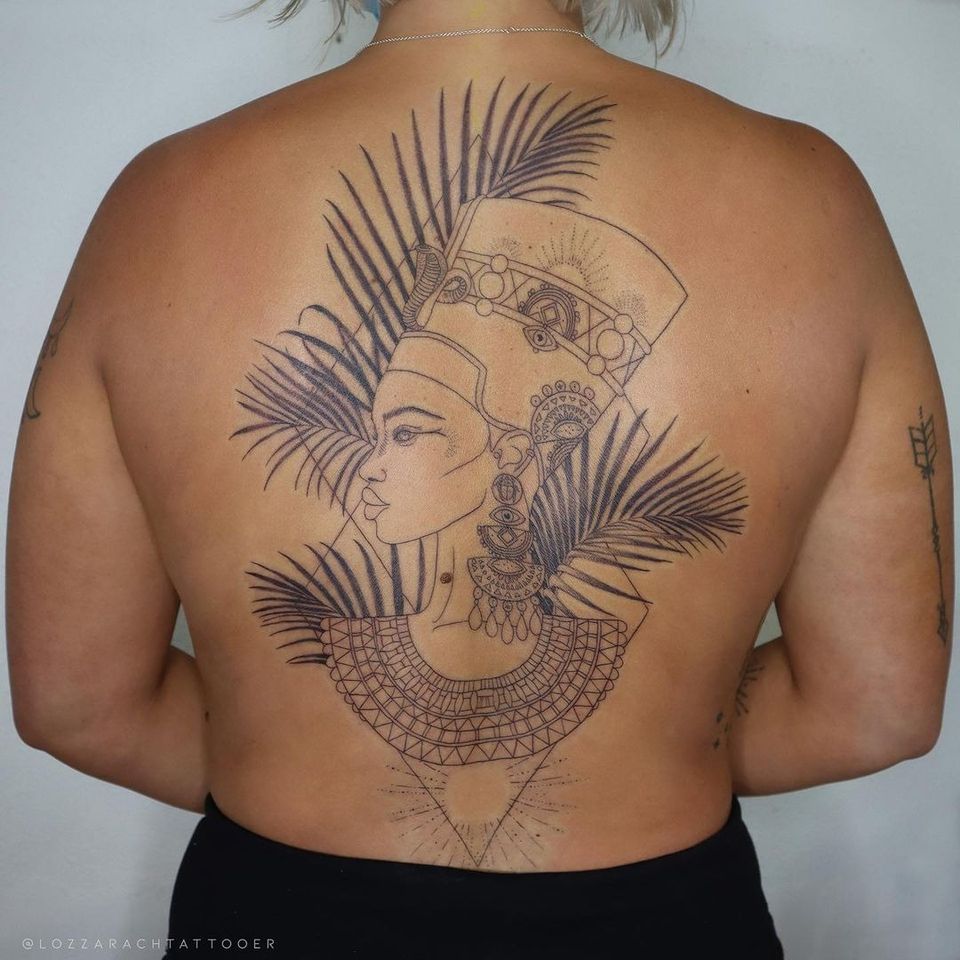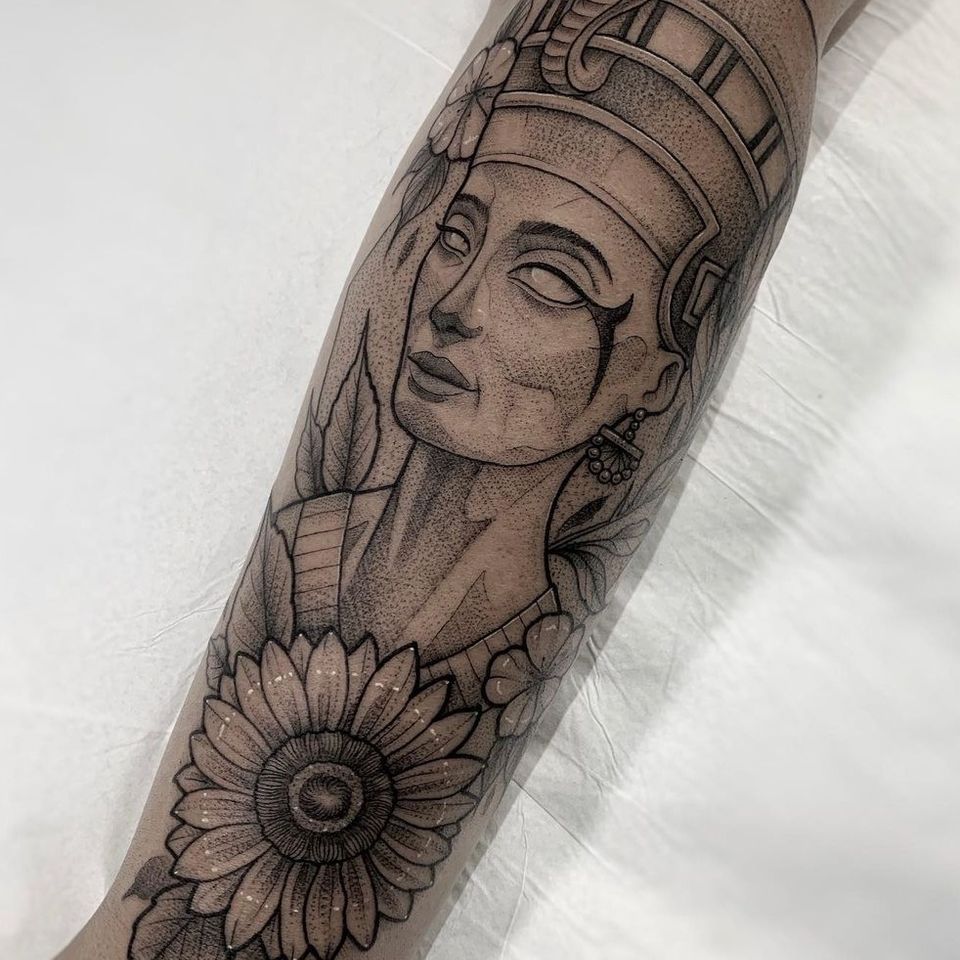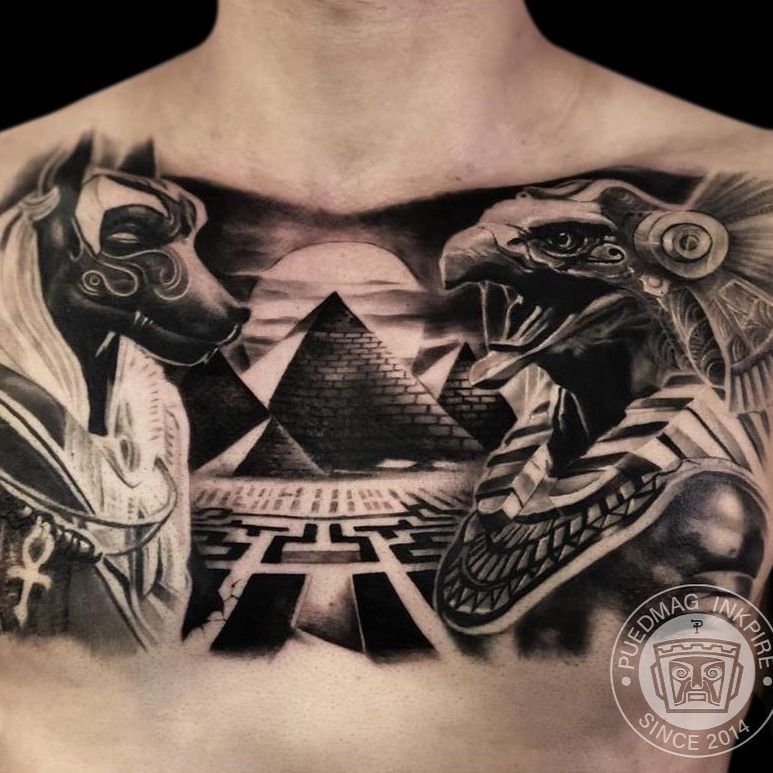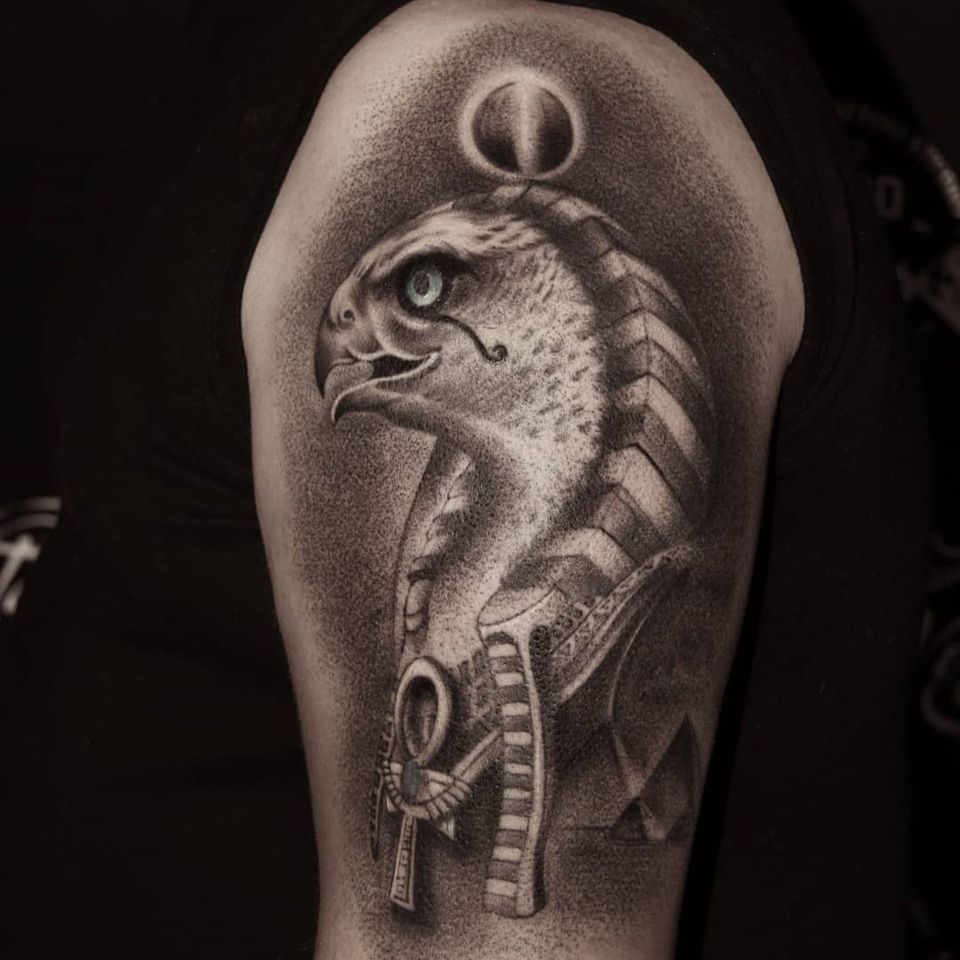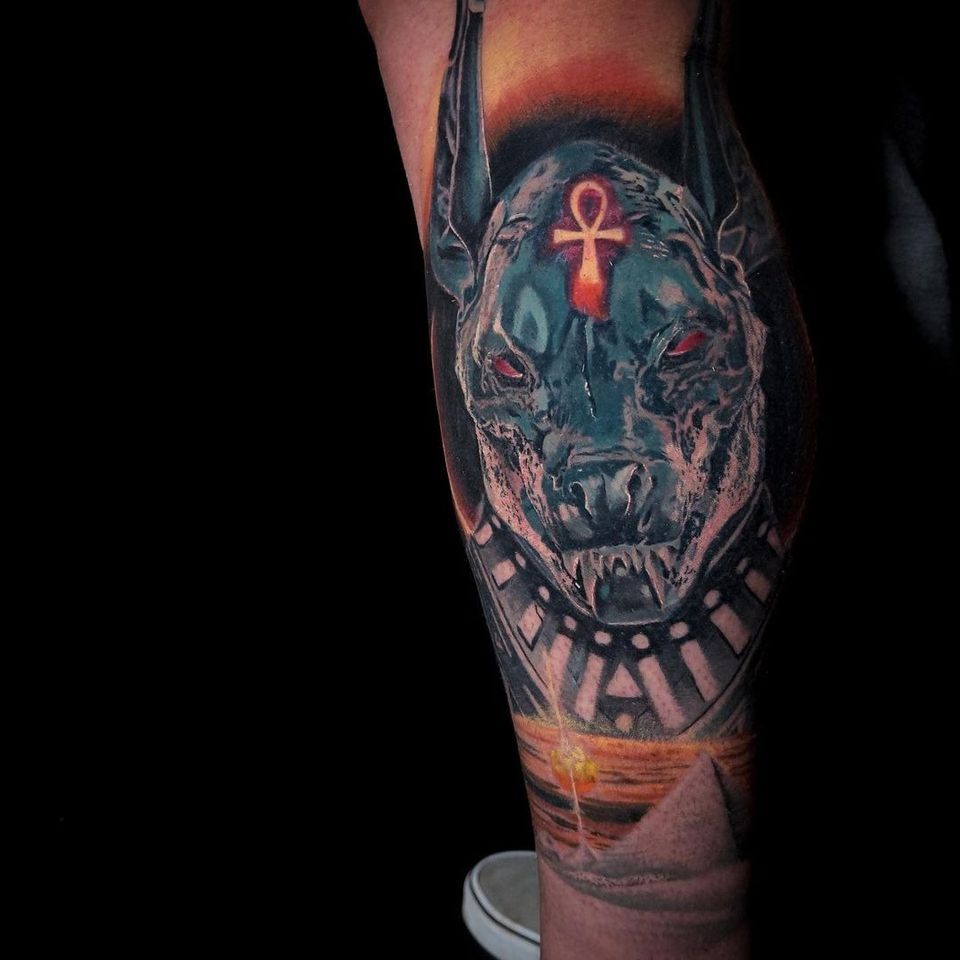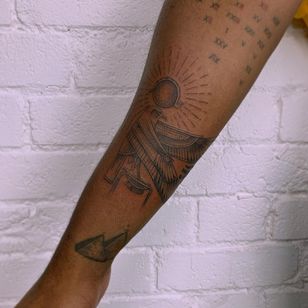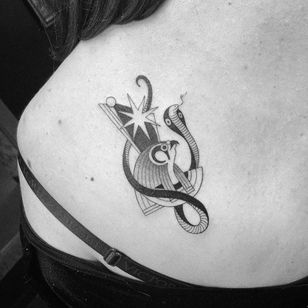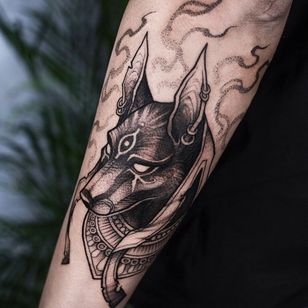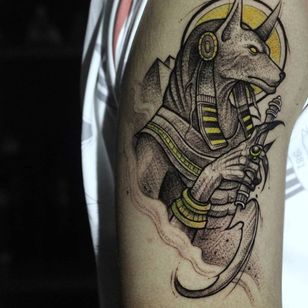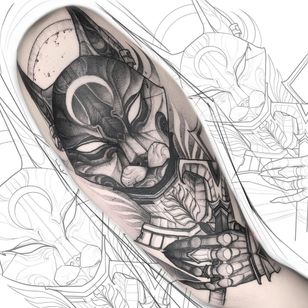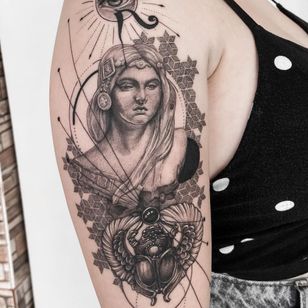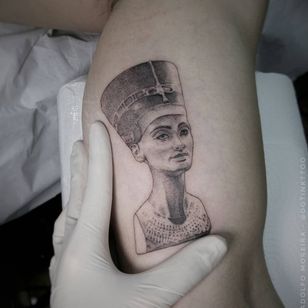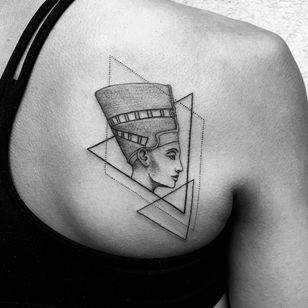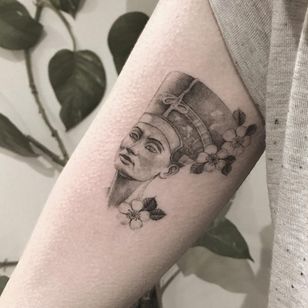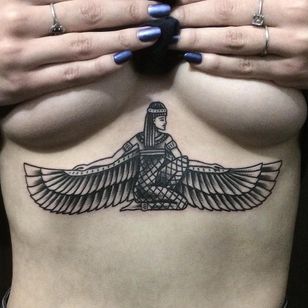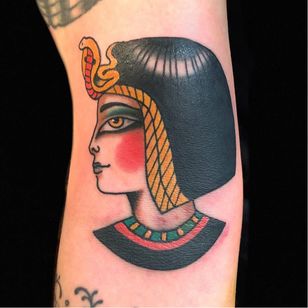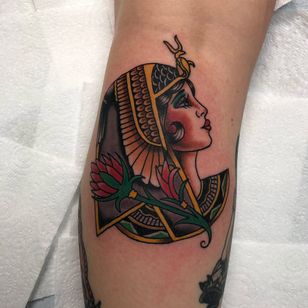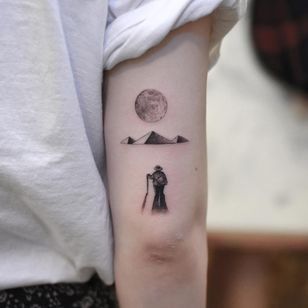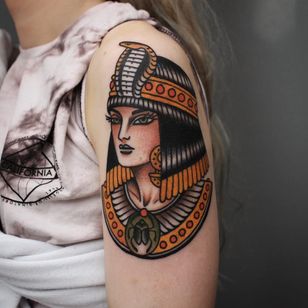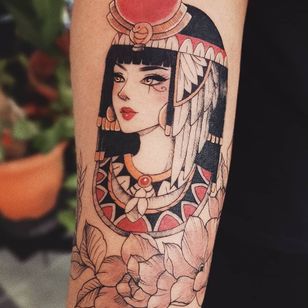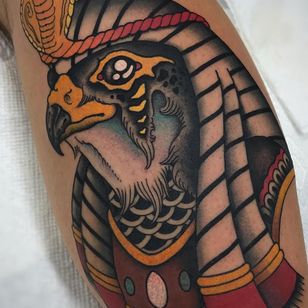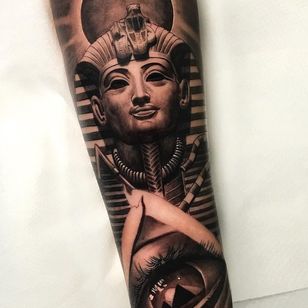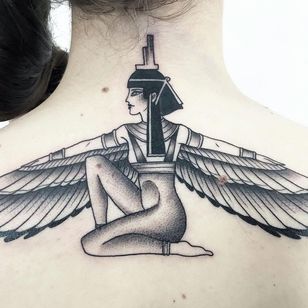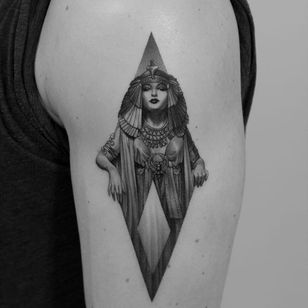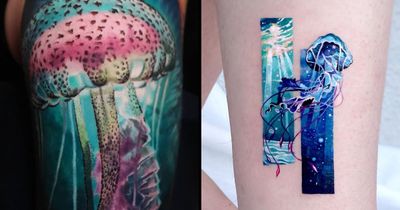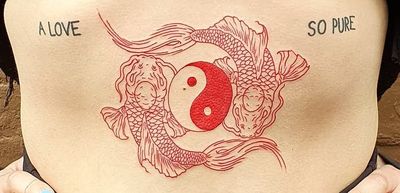What Makes Isis and Horus Smile? Egyptian Tattoos
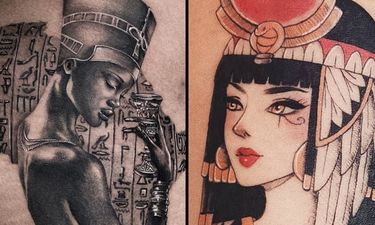
Summary
Wanna walk like an ancient Egyptian? Check out these incredible pieces that show how good Egyptian tattoos can be!
It’s easy to be drawn into the mysterious and awe-inspiring world of ancient Egypt. Whether you’re fascinated by tales of cursed tombs, or mesmerized by the enigma of the pyramids, ancient Egypt offers a wealth of captivating art and mythology to explore. The entirety of Egyptian culture and history is rife with powerful esoteric symbolism; perfect for tattoos that strive to convey spiritual concepts, or whose purpose is to protect and heal the wearer.
For this reason, many people are drawn to tattoos depicting various Egyptian hieroglyphs, deities, rulers, and gods. Thanks to the spiritually-infused nature of Egyptian art and language, symbols can represent several different concepts at once, and often hold multiple layered meanings. This aspect of Egyptian symbolism adds a unique layer of mystery and intrigue to Egyptian tattoos, allowing them to be deeply personal even when highly visible.
In this article, we will explore some of the most popular motifs for Egyptian style tattoos, as well as the best body placements for your design, and important Egyptian figures and symbols to get familiar with!
Top Egyptian Tattoo Questions
What do Egyptian tattoos mean?
Egyptian tattoos can possess many meanings depending on the imagery depicted. Most Egyptian tattoos work to represent spiritual lessons, highlight important historical figures, or showcase appreciation for various gods, goddesses, and deities.
Did Pharaohs have tattoos?
While there are no records of pharaohs with tattoos, it has been discovered that both men and women in ancient Egypt engaged in the practice of being tattooed. While the meaning behind these ancient tattoos is largely unknown, it is believed by some that they possessed a spiritual nature, sometimes being described as “divine formulas”, or even as medicine.
Tattoos in ancient Egypt were also commonly used to denote religious affiliation, profession, or status. A popular example of this lies with the many women who used tattoos to mark them as healers or priestesses. These types of women were commonly associated with the worship of the goddess Hathor, ruler of women, love, fertility, and the sky.
Are tattoos allowed in Egypt?
In modern-day Egypt, tattoos are religiously forbidden according to Sharia law as they are viewed by Sunni Muslims as being a form of bodily mutilation. However, recently a new religious decree found that women may get tattoos for adornment. As of 2015, the Egyptian government doesn't actually even have a tattoo license available for artists hoping to open a studio.
In contrast to today’s times, tattoos were once considered permissible in Egypt for both men and women and were even found among upper-class citizens.
Should I cover tattoos when I visit Egypt?
You do not have to cover your tattoos when visiting Egypt unless you are visiting a mosque. Egyptians are very used to tourist travel, so foreigners with tattoos aren't a rare sight but it's always good to be respectful of the country you happen to be in.
What is the meaning of the Anubis tattoo?
Anubis tattoos are commonly worn to invoke spiritual protection against evil and chaos, but they can also be used to demonstrate concepts like regeneration and “life after death”.
What does the Egyptian eye tattoo mean?
The Egyptian eye tattoo can be a reference to the Eye of Horus or the Eye of Ra. The Eye of Horus tattoo meaning is centered on spiritual protection, as many believe the symbol is capable of warding off evil energies and forces. The Eye of Ra tattoo is believed to possess the destructive power of the sun, as well as the ability to protect buildings and people.
Why did Tupac get a Nefertiti tattoo?
Tupac’s famous Nefertiti chest tattoo came about as a way to honor his mother Afeni Shakur while expressing sentiments of black excellence and feminine strength.
What is the Egyptian symbol for strength?
The Egyptian symbol for strength is known as “Djed”, a hieroglyph regarded as the “backbone of human life”, as well as a continuous source of stable power and strength.
Top Egyptian Tattoo Motifs
Egyptian Cat Tattoo
One of the most revered and cherished animals in ancient Egypt was the domesticated cat. Often saving their owners from poisonous snake and scorpion bites, cats were viewed as essential and beloved protectors within the home.
When designing your Egyptian cat tattoo, remember that you can always experiment with elements like wings, rising suns, or the Eye of Horus.
Tattoo by Shaun Topper #ShaunTopper #Egyptiantattoos #egyptian #egypt #ancient #esoteric #history #cat #kitty #sphinx #jewelry #ankh #scarab #wings #mythicalcreature #jewelry #gold
Ankh Tattoo
The ankh tattoo's meaning is centered upon the concept of eternal life. In ancient times, the ankh was referred to as “the key of life”, and was showcased in Egyptian art as being held by prominent spiritual and political figures. As the ankh symbol tattoo is believed to represent both life on Earth and life after death, this powerful Egyptian symbol can be used as a reminder of the soul’s eternal nature.
Ankh tattoo by omgitsliza #omgitsliza #ankhtattoo #Egyptiantattoos #egyptian #egypt #ancient #esoteric #history
Eye of Horus Tattoo
The Eye of Horus symbol has been used since ancient times to signify protection while enhancing intuition and supercharging the third eye. So, if you are searching for an Egyptian tattoo to encourage physical safety, healing, or regeneration, the Eye of Horus tattoo may a great selection for you!
Eye of Horus tattoo by Jason Sinclair #JasonSinclair #eyeofhorus #eye #Egyptiantattoos #egyptian #egypt #ancient #esoteric #history
Eye of Ra Tattoo
While the Eye of Ra tattoo appear similar to the Eye of Horus, it possesses a different meaning and is connected to the sun’s energy instead of the moon. Those who wear the Eye of Ra tattoo often do so for its strong protective qualities or as a way to channel the masculine energy of the sun.
Ra tattoo by matgogtattoo #matgogtattoo #eyeofra #ra #Egyptiantattoos #egyptian #egypt #ancient #esoteric #history
Pharaoh Tattoo
If you are looking to invite strong leadership qualities into your life an Egyptian Pharaoh tattoo may be the right choice! As a symbol, Pharaohs often work to represent concepts of self-mastery and personal power, making them ideal subject matter for permanent art. So, whether you’re interested in a regal King Tut tattoo or a mysterious Akhenaten design, Egyptian pharaoh tattoos are a powerful way to celebrate Egypt’s history while summoning divine masculine energy.
Pharaoh tattoo by shooby_tattoo #shoobytattoo #pharaoh #Egyptiantattoos #egyptian #egypt #ancient #esoteric #history
Egyptian Gods Tattoo
The ancient Egyptians worshipped many goddesses, gods, and deities; often calling upon them for their powers of protection, wisdom, and fertility. Egyptian god tattoos make for visually compelling and spiritually rich pieces, and can easily be used as symbols for various qualities and sentiments depending on which god or goddess you choose.
Egyptian deity tattoo by sami.ea #samiea #Egyptiantattoos #egyptian #egypt #ancient #esoteric #history
Sphinx Tattoo
Depicted as a monster with a woman’s head and a lion’s body, the sphinx serves as a prominent mythological figure within ancient Egypt. Thanks to the Sphinx’s association with the sun god Ra and its strong protective qualities, it has become an iconic motif for Egyptian-themed tattoos.
Pharaoh and sphinx tattoo by iqbaltattoo #iqbaltattoo #Egyptiantattoos #egyptian #egypt #ancient #esoteric #history #sphinx #pharaoh
Pyramid Tattoo
One of the most easily recognizable symbols of ancient Egypt is the pyramid, making it an excellent motif for any Egyptian-themed tattoo! From hieroglyph accents to imagery of goddesses and pharaohs, the pyramid works well alongside many other Egyptian motifs or on its own.
Tattoo by Kenny Sanchez #KennySanchez #Egyptiantattoos #egyptian #egypt #ancient #esoteric #history #moon #desert #Linework #fineline #travel #camel #pyramids #architecture
Egyptian Scarab Tattoo
The scarab beetle was believed by ancient Egyptian civilizations to represent rebirth, transformation, and protection. In today’s times, the scarab tattoo's meaning remains true to its Egyptian roots, serving as a symbol for regeneration and transcendence.
Scarab tattoo by James Boag #JamesBoag #scarab #neotraditional #ornamental #star #floral #Egyptiantattoos #egyptian #egypt #ancient #esoteric #history
Hieroglyph Tattoo
Believed to be a sacred form of writing, Egyptian Hieroglyph tattoos are an excellent way to show your appreciation for ancient Egypt. Whether you’re interested in symbols that represent deities or designs believed to bring about spiritual protection, hieroglyph tattoos are a great way to illustrate the beauty of Egyptian culture while creating a tattoo ingrained with personal meaning.
Hieroglyph tattoo by ioanaconda #ioanaconda #hieroglyph #Egyptiantattoos #egyptian #egypt #ancient #esoteric #history
Important Egyptian Gods and Pharaohs
Tutankhamun Tattoo
Son of the mysterious Pharaoh Akhenaten, King Tut came to power at just nine years old. During his short reign, King Tut restored Egypt to its polytheistic roots but then died of malaria at age 19. Tut’s tomb was discovered by archaeologists in 1922 and soon became world-famous thanks to the jewelry, gold, statues, and amulets found within.
Today, Tutankhamun tattoos remain a popular way to pay homage to the rich history of ancient Egypt, but can also be used to symbolize royalty, hedonistic tendencies, and strength.
Tutankhamun tattoo by Max Wood #MaxWood #tutankhamun #Egyptiantattoos #egyptian #egypt #ancient #esoteric #history
Nefertiti Tattoo
One of the best Egyptian tattoos for females is the Nefertiti tattoo! Nefertiti’s iconic bust has remained a mesmerizing way to celebrate the beauty and power of ancient Egyptian women. Married to the controversial King Akhenaten, Queen Nefertiti was believed to have changed her name after his passing, proceeding to rule over ancient Egypt in his absence.
While Nefertiti tattoo meanings may differ, the design is commonly used as a way to celebrate African roots, divine feminine energy, and beauty. It has also found use as a symbol of prosperity and progress.
Tattoo by ColdGray #Coldgray #Egyptiantattoos #egyptian #egypt #ancient #esoteric #history #neferetiti #blackandgrey #linework #etching #sculpture #crown #bust #lady #ladyhead #fineart
Anubis Tattoo
Anubis was revered in ancient Egypt as a jackal-headed deity who presided over the underworld and was known to guide souls into the afterlife. Though he is commonly associated with death, the color black used for Anubis’s head was believed to represent the rich soils of the Nile; conveying a concept of rebirth.
A common Anubis tattoo meaning is that of protection, commemorating a loved one lost, or an expression of life after death. When exploring Anubis tattoo designs, it seems one of the most high-impact placements is the Anubis hand tattoo. If you’re looking for a small Egyptian tattoo with a big meaning, this placement might be for you!
Anubis tattoo by maocalderon #maocalderon #anubis #Egyptiantattoos #egyptian #egypt #ancient #esoteric #history #ankh
Bastet Tattoo
Bastet is an Egyptian cat goddess believed to be the protector of women, children, and the home. When exploring Bastet tattoo designs, you can always experiment with motifs like Geometric shapes, ornate jewelry, wings, or the Eye of Ra to personalize your piece.
Bastet tattoo by bohratattoo #bohratattoo #bastet #Egyptiantattoos #egyptian #egypt #ancient #esoteric #history #cat #ankh #goddess
Ra Tattoo
In ancient Egypt, Ra was depicted as a falcon-headed god believed to be the ruler of the sun and creator of all life forms. Ra tattoos can be used to celebrate mystical sun concepts, or as a way to honor the rich mythology and history of Ancient Egypt.
Ra tattoo by snirb tattoo #snirbtattoo #ra #falcon #deity #fineline #sun #Egyptiantattoos #egyptian #egypt #ancient #esoteric #history #hieroglyph
Isis Tattoo
Daughter of the Earth god and sky goddess, Isis was believed by the Egyptians to possess great powers in the realms of magic, healing, and protection. She was said to resurrect the dead at will and was known to preside over matters of love, marriage, and fertility. Thanks to these attributes, Isis tattoos can be a feminine and creative way to invite more harmony, romance, and wellbeing into your life.
Isis tattoo by Mike Ho #MikeHo #isis #goddess #deity #illustrative #Egyptiantattoos #egyptian #egypt #ancient #esoteric #history
Akhenaten Tattoo
Regarded as one of the most enigmatic and controversial kings of Egypt, an Akhenaten tattoo may be perfect for those captivated by Egypt’s mysterious history. Married to Queen Nefertiti and father of King Tut, Akhenaten held an important role in Egyptian history, with some scholars believing that he may have been Moses of the Bible.
When designing your Akhenaten tattoo, complementary design elements often include imagery like pyramids, Nefertiti portraits, crooks and flails, and sun disks.
Akhenaten tattoo and Nefertiti tattoo by jjdukharan #jjdukharan #akhenaten #nefertiti #pharaoh #Egyptiantattoos #egyptian #egypt #ancient #esoteric #history
Cleopatra Tattoo
Known as the last active ruler of ancient Egypt, Cleopatra is remembered for her sharp intellect and tenacious work ethic. When exploring Cleopatra tattoo meanings, concepts are usually centered on ideas surrounding feminism, sensuality, and power.
Cleopatra tattoo by Dani Queipo #DaniQueipo #cleopatra #eye #pharaoh #Egyptiantattoos #egyptian #egypt #ancient #esoteric #history
Thoth Tattoo
Thoth is the gender-fluid Egyptian god believed to maintain the balance of the universe. Thoth tattoos can be used to represent themes of duality, harmony, creative energy, wisdom, secrets, and divinity. A Thoth tattoo can also be a powerful symbol for anyone trying to balance their feminine and masculine energies.
Thoth tattoo by Big Luke tattoo #BigLukeTattoo #thoth #deity #Egyptiantattoos #egyptian #egypt #ancient #esoteric #history
Osiris Tattoo
In ancient Egypt, Osiris was believed to be the god of the underworld, agriculture, and fertility. Though he ruled over the dead, Osiris was also viewed by Egyptians as the god of new life and was said to represent new beginnings. Osiris tattoos can be worn to signify themes of immortality and rebirth.
Osiris tattoo by 82tattoo #82tattoo #osiristattoo #pharaoh #deity #Egyptiantattoos #egyptian #egypt #ancient #esoteric #history
Sekhmet Tattoo
Depicted as a lioness, or a woman with the head of a lion, Sekhmet is ancient Egypt’s goddess of war, disease, healing, and medicine. Though her blood lust for violence was feared, Sekhmet was also considered to be a powerful protector and compassionate healer. Sekhmet tattoos are often worn to represent the protective side of this fierce sun deity and to ward off forces of evil.
Sekhmet tattoo by morriganblackart #morriganblackar #sekhmet #lioness #Egyptiantattoos #egyptian #egypt #ancient #esoteric #history
Top Body Placements for Egyptian Tattoos
Egyptian Tattoo Back
Thanks to the spacious canvas provided by the back, Egyptian-themed tattoos in this location can incorporate great detail. Whether you’re interested in a large-scale Pharaoh portrait or intricate hieroglyphics and pyramids, the back is an excellent placement for any Egyptian-themed design!
Egyptian back tattoo by lozzarachtattooer #lozzarachtattooer #pharaoh #nefertiti #palm #jewelry #ornamental #Egyptiantattoos #egyptian #egypt #ancient #esoteric #history
Egyptian Tattoo Forearm
If you’re interested in a stunning Nefertiti bust or an ankh cross tattoo, the forearm is an ideal area to show off your Egyptian style designs. This placement offers high-visibility for your art while offering space for detail and various design elements.
Egyptian forearm tattoo by rjart #rjart #nefertiti #illustrative #sunflower #pyramid #cobra #Egyptiantattoos #egyptian #egypt #ancient #esoteric #history
Egyptian Tattoo Chest
Egyptian chest tattoos work wonderfully to showcase high-impact battle scenes, portraits of rulers, or protective symbols like the Eye of Horus. As this area is typically covered, the chest is also a great placement for those seeking more discretion with their design.
Egyptian chest tattoo by puedmag_inkpire #puedmaginkpire #chesttattoo #pyramid #ra #anubis #maze #blackandgrey #realism #Egyptiantattoos #egyptian #egypt #ancient #esoteric #history
Egyptian Tattoo Upper Arm
If you’re thinking of beginning an Egyptian tattoo sleeve, the upper arm may be an optimal placement to consider! Perfect for showcasing Egyptian gods, goddesses, and rulers, this location will provide ample design space while allowing for visibility in warmer months.
Upper arm Egyptian tattoo by jafarli tattoo baku #jafarlitattoobaku #horus #ankh #Egyptiantattoos #egyptian #egypt #ancient #esoteric #history #blackandgrey
Egyptian Tattoo Calf
Whether you’re considering a bold Egyptian cross tattoo or a powerful Black and Grey Anubis tattoo design, the calf is an excellent place to showcase vertically oriented imagery.
Egyptian calf tattoo by Maxime Alvarez #MaximeAlvarez #anubis #ankh #pyramid #Egyptiantattoos #egyptian #egypt #ancient #esoteric #history #color #realism
We hope that these Egyptian tattoo ideas have helped to inspire you for your next tattoo! If you’re interested in more Egyptian tattoos, check out 16 Symbolic Anubis Tattoos.
